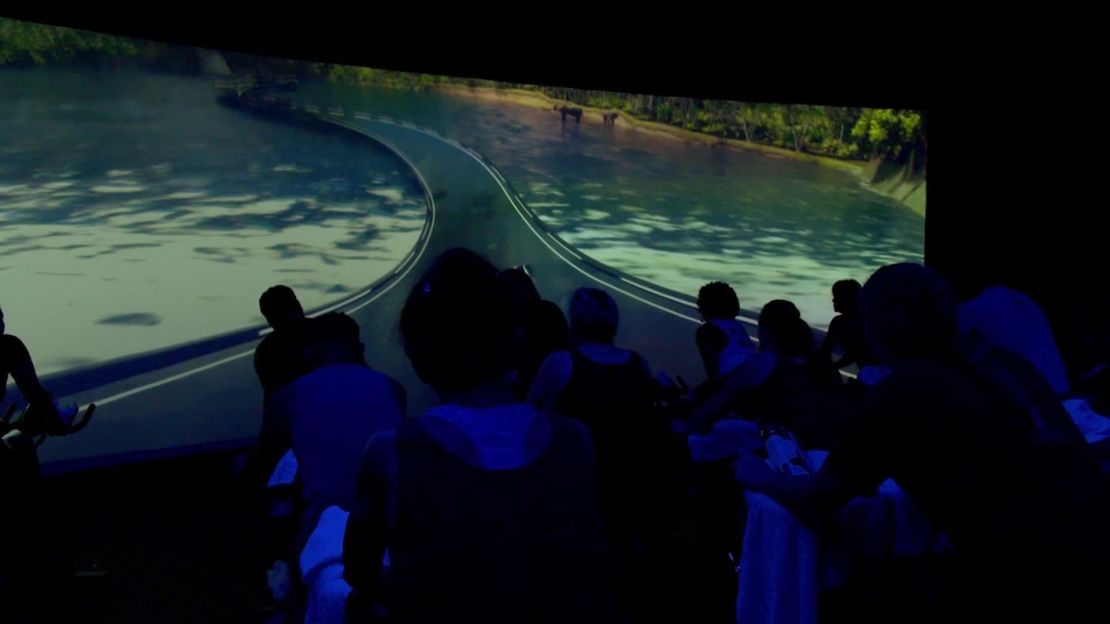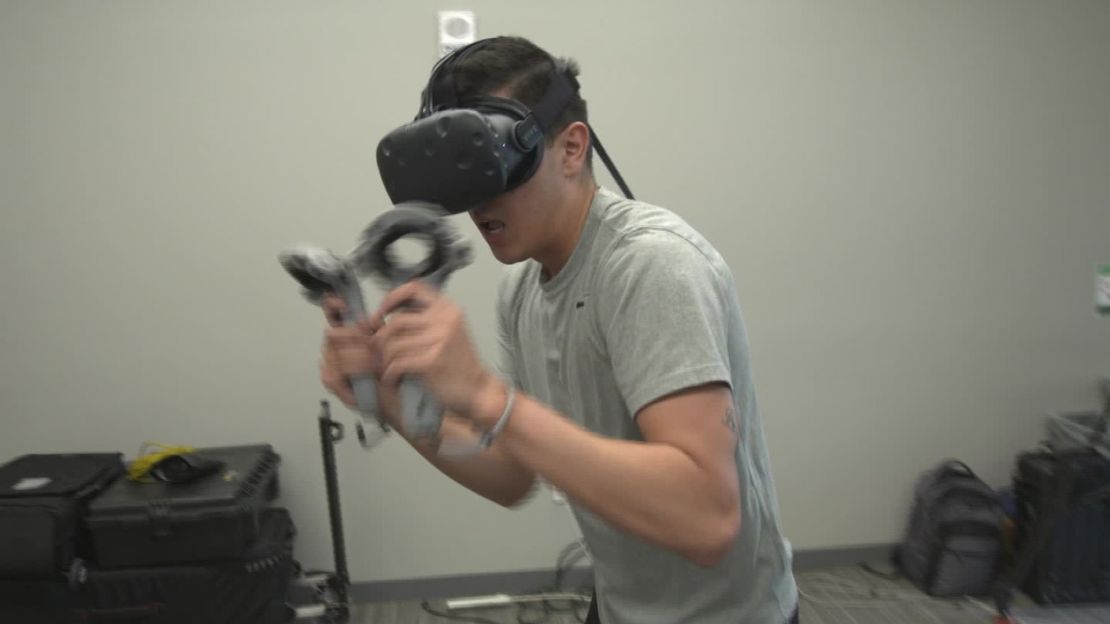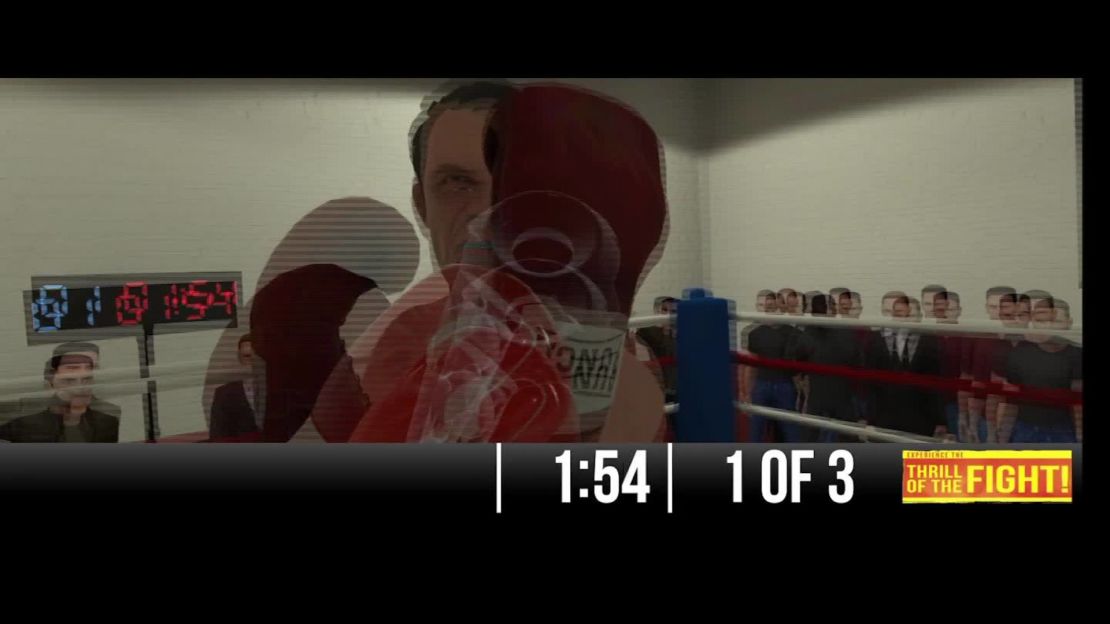The spin instructor let out a loud “Woooo!!” as she led her students up hills, through rings of fire and outer space. They even rode through jungles, deserts and fantasy worlds.
It’s part of a trend called “immersive fitness,” harnessing the power of sound, visuals and sometimes scent to immerse exercisers in different environments.
CNN recently observed a class at 24 Hour Fitness in Santa Monica called “The Trip” which is offered in just a handful of gyms in the U.S. The elaborate videos appeared on floor-to-ceiling 3-D screens and were synchronized to music.
The spin students peddled in a room lit mostly by the screens. They leaned their bikes side to side, up and down as if they’re riding the curves and hills in front of them.

“You’re out of reality and you’re in this other little land,” said spin student and makeup artist Kriz Crane. “The fact that it has the screen makes you forget how hard you’re working.”
Forget you’re working out or lose yourself in “ohhhms”
Community researcher Juan Barron said he likes riding through mountains or a forest without ever leaving the room. “It gives you a little bit of the outside inside.”
Frank Ferrante, who has been taking this class for three years, says regular spin classes bore him.
“I experienced virtual reality in the sixties a lot,” he kidded. “With this class it’s an IMAX screen and a narrative. Going through the jungle, going through the water, going through the fire- and associating that with what’s going on in my own life – I push myself that much harder to transcend that.”

But for some, all the excitement takes getting used to.
“If you get dizzy really easily, the instructors beforehand tell you to just look at the floor and you orient yourself again,” said student Iris Helle, who says dizziness is not a problem for her.
“You start watching this wonderful video game and you get to work out at the same time.”
Immersive fitness is also used in some yoga classes - although on the more chill end of the spectrum.
The Woom Center in New York City immerses its yoga practitioners in surround screens and 3-D sound systems to optimize relaxation though vibrations and colors.
The website describes it as “the holistic lovechild of east and west, tradition and innovation.”
Virtual Reality boxing, dancing
For true virtual reality experiences, some gyms offer headsets with screens fed by gaming software. The packages often include sensors worn or held during the workout.
When you move, the virtual world responds. Right now just a handful of gyms around the country have these stations. The challenge is wiping down the equipment between users in an efficient and sanitary way- and getting enough space for gamers to move around, said Aaron Stanton, Director of the VR Health Institute at San Francisco State.
He believes virtual reality will be in most gyms across the country in the near future.
And then there’s bringing virtual reality into your home.
If you have the space, generally six square feet, you can set up a VR station. The VR headset prices range anywhere from $350 to $800.
Some headsets come with a few games loaded but otherwise you need to buy the games separately. You also need a good PC that can handle the high frame rate that makes these games effective.
Study finds VR games can be effective exercise
Stanton sees a future beoynd the couch potato videogamer stereotype where game designers will consider fitness in their new products. He says VR games hit a demographic that “doesn’t onrmally ike traditional exercise.” Stanton teamed up with San Francisco State’s Department of Kinesiology to test his theories. The lab found 30% of virtual reality games now on the market actually give you pretty good exercise.

Their study published last year put 41 men and women ages 18 to 39 through three games and measured their oxygen consumption and heart rates. One game called “Audioshield” sends colored orbs at the player. The object of the game is to use the correct hand to match the color. The orbs are high and low so the player is bending and reaching. The day CNN visited the lab, kinesiology graduate student Angelina Wong was testing it out. She was moving almost as if she was taking an aerobics class.
“It’s definitely a thinking process too because you have to match your hand with the color of the orb,” said Wong.
Another game tested called “Hollowpoint” involves holding a virtual bow and arrow to shoot at targets in virtual reality while dealing with leaping ninjas. The third game, “Thrill of the Fight” is a virtual boxing match. Players experience fighting in a boxing ring as a formidable opponent jabs at them. The sounds of swings and punches are visceral.

But you never actually feel a punch of course. “So that’s a big benefit. You’re not going to end up with a black eye.” said Marialice Kern, Chair, Department of Kinesiology at San Francisco State.
“Our research found that indeed the three games fell into basically the moderate to vigorous intensity exercise (categories)” equivalent to running on a track at 5 miles an hour or riding a bike vigorously said Kern. “From what we’ve tested in the lab, we see indeed you can get a great workout from virtual reality,”
The researchers also tracked the “rating of perceived exertion” – the amount of effort the people thought they put out. Kern said the participants all believed they were working out with lower intensity than the physiological data reflected. That same result was found in past studies.
“Virtually reality exercise is a really, really good at being able to distract you from the fact that you were exercising and letting you just enjoy the game,” said Stanton.
Nausea can be a problem for some
While most of the study participants did not experience nausea or vertigo while playing in a virtual reality world, it does happen.
“Anyone who’s working in virtual reality and not considering (motion sickness) is fooling themselves,” said Stanton.
When graduate student Angelina Wong first started playing one of the VR games, she said she felt a little motion sickness at first, “because the environment is moving at you. It kind of feels like you’re on a moving platform.”
She felt like, “kind of losing balance, but once you kind of loosen up and relax a little bit, you’ll get the feel of the game.”
There are games where half the people who play have to stop half way because they’re getting sick. But nausea is 99 percent dependent on what program or software the person is playing, he said. Basically, you have to choose the right game for you and your experience level. So what’s least likely to cause motion sickness? Games where, “I take one step to the right - and in the game my character takes one step to the right. It’s a one-to-one motion with real life,” Stanton explained. There are games that don’t do that and if you move one step forward you actually go quite a bit farther in the game than in real life.
“That’s where it starts messing with their sense of depth perception,” and might make some people nauseous or experience vertigo.
Stanton had me try out a game called “Fruit NInja” where the sensors in my hands simulated large swords. Colorful fruits flew towards me and I had to slice them in half. I did not feel any motion sickness and had a great time. But that game didn’t bring up my heart rate too much either. Another safety consideration – space. If you’re thinking of buying a VR set up for your home, you need at least six square cleared of furniture or objects that you can potentially trip on.
Not many VR games designed for fitness yet
Right now there aren’t many virtual reality games designed specifically for fitness. But Stanton and Kern hope game designers will step it up. Only 21 percent of adults are getting the minimum amount of moderate intensity exercise a week needed to get protective health benefits, said Kern. That breaks down to 30 minutes a day five times a week.
“We are not a fit nation. The word exercise has a bad rap for most people,” she said. Exercising for the sake of exercise is not really a great motivator she said. The more fun moving is- the more likely we’ll get people fit.
“Just put in a different game, a new experience will totally change the kind of exercise you’re doing,” Kern suggested.
“If you have some kind of movement that actually elevates your heart rate whether that’s walking your dog, whether that’s playing any of the VR games –
you need to do something to move.”






